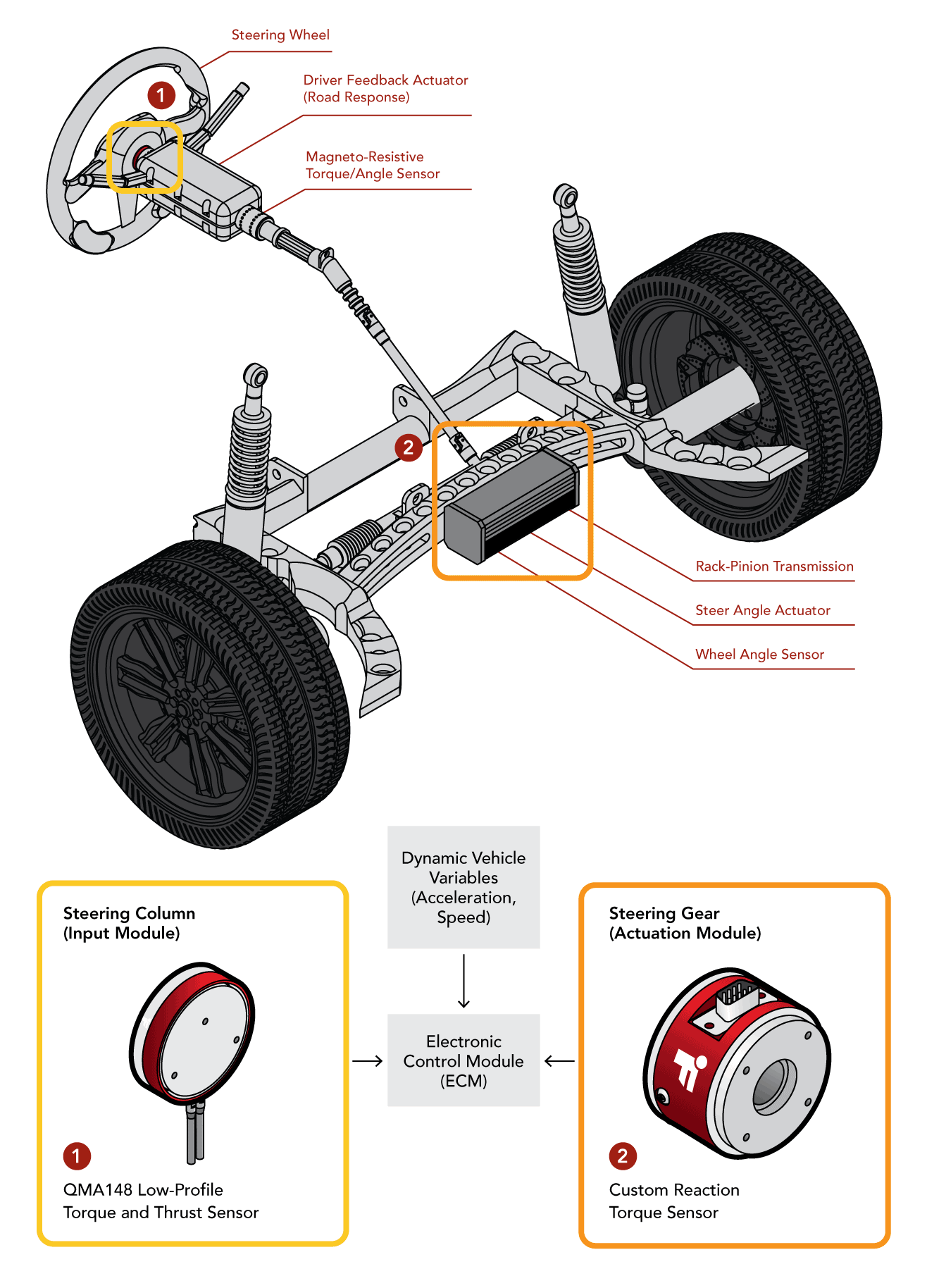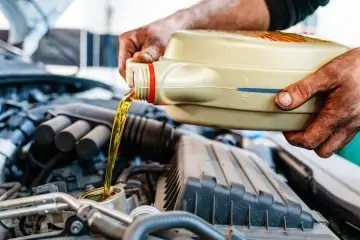“Dynamic Steering Torque Service Required” indicates a problem with your vehicle’s dynamic steering system. Immediate professional inspection is necessary to avoid potential driving hazards.
Dynamic steering torque is a crucial feature in modern vehicles, designed to enhance driving comfort and safety. This system uses an electric motor attached to the steering gear to adjust the amount of torque required for steering based on the driving situation.
If you encounter a “Dynamic Steering Torque Service Required” alert, it means there is an issue with this system. Addressing this promptly is essential, as unresolved problems can lead to increased difficulty in steering and compromised vehicle control. For accurate diagnostics and repairs, consult a professional mechanic to ensure your vehicle remains safe and functional.

Credit: www.futek.com
Dynamic Steering Torque Basics
Understanding Dynamic Steering Torque is essential for modern car owners. This technology greatly improves the driving experience. It adjusts the steering effort based on driving conditions. Let’s dive into the basics.
Definition
Dynamic Steering Torque is a system that uses an electric motor attached to the steering gear. The motor adjusts the torque needed to steer the vehicle. This makes steering easier or harder based on the situation.
How It Works
The system senses various driving conditions. It then adjusts the steering effort accordingly. Here’s a breakdown of how it functions:
| Driving Condition | Steering Adjustment |
|---|---|
| Low Speed | Less Torque Needed |
| High Speed | More Torque Needed |
| Slippery Roads | Increased Stability |
The system uses sensors to monitor the driving environment. These sensors collect data on speed, road conditions, and driver input. The electric motor then adjusts the steering torque. This ensures optimal steering performance at all times.
- Improves driving comfort
- Enhances vehicle control
- Reduces driver fatigue
Vehicles with Dynamic Steering Torque are safer and more enjoyable to drive. Understanding this system helps in maintaining your car better.

Credit: m.youtube.com
Common Issues
Dynamic Steering Torque Service Required is a common alert. This alert signals problems within the dynamic steering system. Understanding these issues helps in timely maintenance.
Error Messages
Error messages are crucial indicators of system faults. Here are common error messages:
- Service Dynamic Steering Torque
- Service ESC System
- Service Antilock Brake System
These messages appear on the dashboard. They indicate various underlying issues.
Symptoms
Recognizing symptoms early can prevent major problems. Here are common symptoms:
- Steering wheel feels heavy or unresponsive
- Vibrations in the steering wheel
- Frequent dashboard alerts
These symptoms suggest immediate attention is needed. Schedule a service to avoid further complications.
Causes Of Service Alerts
Experiencing a Dynamic Steering Torque Service Required alert can be frustrating. Understanding the causes behind these alerts can help you address the issue promptly. Generally, these alerts can be triggered by several factors.
Malfunctioning Sensors
Sensors play a crucial role in the dynamic steering system. They ensure the smooth operation of your vehicle’s steering. When sensors malfunction, they send incorrect data to the control unit.
- Faulty steering angle sensors
- Damaged torque sensors
- Worn-out wheel speed sensors
These malfunctioning sensors can lead to inaccurate steering adjustments. This triggers the service alert on your dashboard.
Software Issues
The dynamic steering system relies on software algorithms to interpret sensor data. Software issues can disrupt this process.
- Corrupted software updates
- Compatibility issues with other vehicle systems
- Glitches in the control unit’s programming
These software problems can cause the system to misinterpret data. This results in a Dynamic Steering Torque Service Required alert.
Diagnosing Problems
Experiencing a Dynamic Steering Torque Service Required message on your dashboard? Diagnosing the issue properly is essential. It helps ensure your vehicle’s safety and performance. This guide will walk you through the necessary tools and steps to diagnose the problem effectively.
Tools Needed
- OBD-II Scanner
- Multimeter
- Vehicle Service Manual
- Basic Hand Tools
- Safety Gloves and Glasses
Step-by-step Guide
-
Connect the OBD-II Scanner:
Plug the OBD-II scanner into the port under the dashboard. Turn on the ignition but don’t start the engine.
-
Read Error Codes:
Use the scanner to read error codes. Note down any codes related to the steering system.
-
Consult the Vehicle Service Manual:
Refer to your vehicle service manual for the meaning of the error codes. Look for specific diagnostics related to the codes.
-
Check Electrical Connections:
Inspect all electrical connections to the steering module. Ensure there are no loose or corroded connections.
-
Test the Battery Voltage:
Use a multimeter to check the battery voltage. A weak battery can cause steering issues. Ensure it is within the recommended range.
-
Inspect the Steering System:
Perform a visual inspection of the steering system components. Look for any signs of wear, damage, or leaks.
-
Reset the Error Codes:
After checking and addressing any issues, use the OBD-II scanner to reset the error codes. Monitor if the error reappears.
-
Test Drive the Vehicle:
Take your vehicle for a test drive. Ensure the steering is functioning correctly and the error message does not return.
Fixing The System
The Dynamic Steering Torque Service Required alert can be a daunting issue. This system is vital for a smooth and safe driving experience. When it malfunctions, it affects the vehicle’s steering capabilities. This section will guide you through fixing the system.
Diy Solutions
Some issues can be resolved without professional help. DIY solutions are cost-effective and can save time. Here are a few steps:
- Check the Steering Fluid Levels: Low fluid can trigger the alert. Refill the fluid to the recommended level.
- Inspect the Steering Column: Look for any visible damage or loose connections. Tighten any loose parts.
- Reset the System: Disconnect the battery for a few minutes and then reconnect. This can reset the system and clear minor issues.
If these steps don’t resolve the issue, it may be time to see a mechanic.
When To See A Mechanic
Some problems require professional expertise. Here are signs that you should consult a mechanic:
- Persistent Alert: If the alert remains after performing DIY solutions, seek expert help.
- Strange Noises: Unusual sounds from the steering system indicate deeper issues.
- Difficulty Steering: If the steering becomes stiff or unresponsive, it’s unsafe to drive.
Professional mechanics have the tools and knowledge to diagnose and fix complex problems. Always prioritize safety and consult a mechanic for persistent issues.

Credit: jeepinside.com
Cost Considerations
Dealing with a “Dynamic Steering Torque Service Required” warning can be stressful. Understanding the costs involved can help. This section breaks down the repair costs and offers maintenance tips to keep expenses down.
Repair Costs
Repair costs can vary depending on the extent of the issue. Here’s a table summarizing the potential expenses:
| Service Type | Estimated Cost |
|---|---|
| Diagnostic Check | $50 – $100 |
| Steering Sensor Replacement | $200 – $400 |
| Full Steering System Overhaul | $800 – $1,500 |
Costs can be influenced by the make and model of your car. Always get multiple quotes from different mechanics. Ensure they have experience with dynamic steering systems.
Maintenance Tips
Regular maintenance can prevent costly repairs. Follow these tips to maintain your dynamic steering system:
- Check the steering fluid level monthly.
- Inspect the steering column for wear and tear.
- Schedule annual diagnostic checks.
- Ensure the steering motor is free from debris.
A well-maintained steering system can extend the life of your vehicle. It also ensures a safer driving experience.
Preventive Measures
Maintaining the dynamic steering torque system in your vehicle is crucial. Preventive measures help avoid expensive repairs and ensure a smooth driving experience. Below are the key areas to focus on.
Regular Maintenance
Adhering to a routine maintenance schedule is essential. Regular inspections can identify potential issues before they become severe. Pay close attention to the following:
- Check the steering fluid levels regularly.
- Inspect the steering system components for wear and tear.
- Ensure the electric motor attached to the steering gear is functioning properly.
Scheduling periodic maintenance with a professional mechanic is advisable. They can conduct thorough checks and perform necessary adjustments. This proactive approach can save you from unexpected breakdowns.
Driving Habits
Your driving habits significantly impact the longevity of the dynamic steering system. Here are some tips to consider:
- Avoid making sharp or sudden turns at high speeds.
- Drive smoothly and maintain a consistent speed.
- Be mindful of road conditions and avoid potholes.
Additionally, parking in a safe and level area can reduce strain on the steering components. Practicing mindful driving habits helps in extending the life of your vehicle’s steering system.
| Maintenance Task | Recommended Frequency |
|---|---|
| Steering Fluid Check | Every 3 months |
| System Inspection | Every 6 months |
| Professional Maintenance | Annually |
By following these preventive measures, you can ensure the dynamic steering torque system remains in optimal condition. Regular maintenance and conscious driving habits are key to a safe and enjoyable driving experience.
Advanced Topics
Understanding Dynamic Steering Torque Service Required can be challenging, but it’s crucial for maintaining your vehicle’s optimal performance. This section delves into advanced topics, focusing on the integration with Electronic Stability Control (ESC) and future technologies related to dynamic steering systems.
Integration With Esc
Electronic Stability Control (ESC) plays a vital role in vehicle safety. It helps prevent skidding and loss of control. Dynamic steering torque systems are integrated with ESC to enhance this safety feature. The integration ensures smoother handling and better control. When ESC detects a potential loss of control, it communicates with the dynamic steering system. This communication adjusts the steering torque accordingly, providing the driver with better control.
This integration works through a series of sensors and actuators. These components continuously monitor the vehicle’s speed, direction, and steering angle. They provide real-time data to the ESC and dynamic steering systems. The integration not only improves safety but also enhances the driving experience. It provides a seamless and responsive steering feel.
Future Technologies
The future of dynamic steering systems looks promising with advancements in technology. One of the most exciting developments is the integration of artificial intelligence (AI). AI can predict and respond to driving conditions more accurately. It uses data from various sensors to optimize steering torque in real-time. This can lead to more personalized and adaptive steering responses.
Another promising technology is the use of advanced materials in steering components. These materials can reduce weight and increase durability. This results in more efficient and longer-lasting steering systems. Additionally, wireless technologies are being explored for communication between different vehicle systems. This could lead to more seamless integration and quicker response times.
The development of autonomous vehicles also impacts dynamic steering technologies. Autonomous systems require precise and reliable steering control. As these technologies evolve, they will likely incorporate more advanced steering torque management systems. These advancements will not only improve safety but also provide a more comfortable and enjoyable driving experience.
Frequently Asked Questions
What Is Dynamic Steering Torque?
Dynamic steering torque adjusts the steering effort based on driving conditions using an electric motor, enhancing comfort and control.
What Does Service Esc Mean On A Jeep Compass?
Service ESC on a Jeep Compass means the Electronic Stability Control system needs attention. It helps maintain vehicle stability.
What Is The Meaning Of Dynamic Steering?
Dynamic steering adjusts the steering ratio based on speed and driving conditions. It enhances control and comfort.
Why Won’t My Jeep Compass Suddenly Start?
Your Jeep Compass might not start due to a dead battery, faulty starter, fuel system issues, or ignition problems.
Conclusion
Understanding the importance of dynamic steering torque service is crucial for vehicle safety and performance. Address any service requirements promptly to ensure smooth, controlled driving. Regular maintenance can prevent costly repairs and enhance your driving experience. Stay proactive and consult a professional for any steering-related concerns.
Keep your vehicle in top condition and enjoy a safer ride.

